Bordeaux Travel Guide
1 / GENERAL
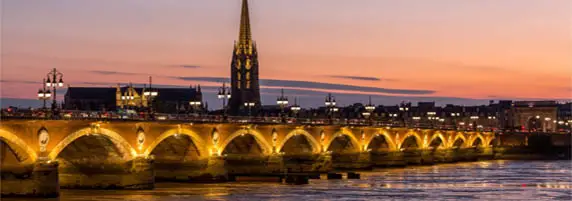
Area : 49.36 km²
Population Density :4,363 per km²
Name of Inhabitants :Bordelais and Bordelaises
Region : Aquitaine
Twin Cities : Bilbao, Quebec, Saint-Pertersbourg, Los Angeles, Munich, etc
Other Names : “Pearl of Aquitaine”, “Sleeping Beauty”, “Burdigala” from the 1st century A.D. that means Gallic city
Map : Google Maps
2 / TRANSPORT
BY CAR
Near the Atlantic Ocean, Bordeaux is a knot of highways in France and even globally in Europe. 580 meters separate Bordeaux by highway A1. Other large French cities like Limoges, Clermont-Ferrand, Lyon, Pau and Bayonne or the Spanish border are easily accessible by highway A62, A65, and A63. To reach the city by car, you’ll take the Rocade, the longest belt highway in France, which measures 45 km. Once in the city, we recommend taking public transportation, which is readily available.
The different relay parking lots allow you to leave your car in a safe place and get to a nearby tram station to get to the city center while avoiding traffic jams and paying a lot for parking. Relay parking lots are free or not too costly depending on the situation.
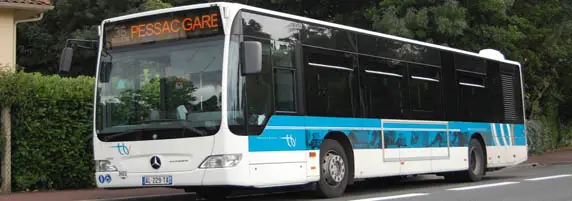
BY BUS / TRAMWAY
In fact, the transportation network, named TBC makes available 3 tram lines, 65 bus lines, and shuttle services through Flexo and Résago (that service a limited area for free and who should be called in advance) to provide simple access to the 8 cantons and 28 communes in Bordeaux.
The city’s public transportation also includes the Batclub, which is in reference to 2 shuttle lines that connect the two banks of the Garonne (number of travelers is limited to 45 people, 15 kids under 12 at maximum). There is no metro in Bordeaux since it was judged to be too complicated to install. Additionally, the city is very beautiful, so it would have been a shame to take an underground train to get to another part of the city. To enjoy the city’s beauty, take one of the 1,500 VCUB bicycles available in 100 terminals within the city. Over 200km of bike paths have been planned, so don’t hesitate. If you are afraid that the bike seat is too painful for you to ride, you can use the car sharing service, Citiz, qthat offers hundreds of vehicles of suitable sizes in over 30 stations.
To legally use public transportation (which runs from 5 am to 1 am), you have the choice between many combined plans cgiving you unlimited access to the network, parking lots, bicycles, and even certain museums with the Citypass. You’ll find many places to get a transportation ticket. You can even buy one in advance to save some time thanks to the e-boutique !
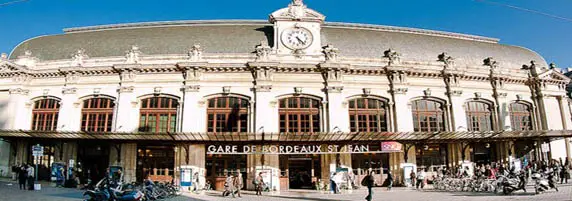
BY TRAIN
To arrive in Bordeaux without a car, you can take the Tgv
The main trains station is called Bordeaux St-Jean, and is located in a lovely building built in the 19th century to replace a station that had become too small. This historical monument has one of the largest glass canopies in Europe. The TGV trains that are leaving or arriving make connections to Spain and larger French cities like Paris in just 3 hours. Intercité and TER trains allow you to get to Montpellier, Marseille, Nice, Limoges, or Bayonne.
The station is serviced by transportation that lets you get to the city center or other city neighborhoods: the C tram and bus lines 9, 10, 11, and 16.
Two other train stations that are serviced by the transportation network, also give access to the “Sleeping Beauty”: the Cénon and Pessac train stations. You’ll find more information here.
Go the SNCF web site to see which station seems the most interesting in relation to your departure city.
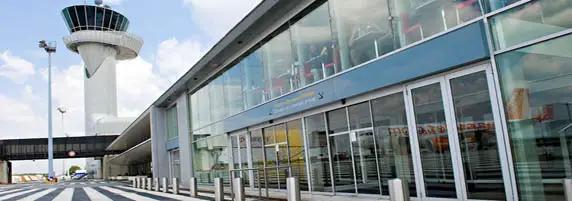
BY PLANE
The Bordeaux Merignac Airport is, of course, outside the city (10 km to the west), but you can get to the Sleeping Beauty thanks to bus line 1 or Jet’Bus, a special shuttle.
The lines for the different companies take you to the larger French cities as well as European cities and those in the Mediterranean basin in just a few hours.
3 / WHEN TO GO?
- In winter, sif you don’t want to put up with up with the crowds or the summer heat. You’ll enjoy the antique shops in January, the sales in February, and the Foire aux Plaisirs being a big local celebration organized on Place des Quiconces during the first three weeks of March.
- In spring, the International Fair of Bordeaux is a big show where you’ll find what you need to brighten up your day and your home. From mid-June to the end of June, don’t miss out on the Epicuriales, an event that celebrates fine cuisine, wine, and music for 15 days among many events.
- In summer, if you want to enjoy this lovely region with a pleasant climate and events in Bordeaux.
4 / INFORMATION AND USEFUL ADDRESSES
Tourism Office : City’s web site
Emergency number: 112 (Euro zone, 112 redirects you to numbers 15, 17, 18, 115, and 119)
Fire: dial 18
Ambulance (medical emergency): dial 15
Police: dial 17
Missing children: dial 116
5 / BUDGET IN BORDEAUX
Accommodation :
The following prices are indicative. They refer to a one night stay in a standard double bedroom and may be subject to confirmation at the time of booking.
- Less than 50€, you can stay in a 2 or 3 star establishment that may be well located
- Between 50€ and 100€, some 2, 3, and 4 star establishments welcome you with a modern, traditional, or elegant décor in different neighborhoods in the city.
Take a look at our website to find a place to stay in Bordeaux
Restaurants :
The following prices are indicative. They refer to the price of one course or a menu for one.
- Less than 5€- A canelette, the popular crepe variety of the traditional cannelé that you can try at the Chartrons market
- A traditional cannelé in one of the Ballardran boutiques. You’ll find different addresses on their web site where you can buy them.
- Bread or another treat that was just taken from the oven in the bakery owned by Laurent Lachenal, who has worked with Eric Kayser.
- One or several macarons from among the 18 flavors offered by Philippe Andrieu, a pastry chef who has worked with Pierre Hermé and at Lenôtre.
- A meal (main dish and appetizer or dessert) at the restaurant, L’eau à la Bouche, managed by a culinary blogger. You’ll be able to try original and refined dishes.
- A dish or a snack with coffee, known for its hot drinks, Books & Coffee.
- A meal at La Cagette, the chic dining hall that offers tarts, salads, and meat based dishes.
- A divine and uncommon hamburger accompanied with fries as well as a dessert for 14€ at the FrenchBurgers food truck.
- A meal from the 1 star restaurant Septième Péché that will surprise your taste buds with its quality ingredients cooked with just a bit brilliance.
- A meal that will allow you to discover the flavors of the southwest at the restaurant, L’Assiette du Vieux Saint-Pierre.
For something to drink :
- Jamon Jamon, a tapas bar- shop and restaurant by day – in which you can have a nice glass of red wine with flavorful tapas. Expect to pay between 10 and 15€ per person for a friendly drink.
- In Camelot, you’ll spend 2.50€ for a pint of beer, 4€ for a glass of wine, or 5€ for a cocktail in a nice and friendly pub in the city center.
- A Baroque style with electro music accompanying a savory cocktail at Azuli Bar.
Public Transportation :
1 ticket: 1.50€
from 5am to 1am
6 / UNMISSABLE VISITS!
The Tourism Office’s website is very well done. There you’ll find suggestions for your visit depending on your interests as well as more precise information. We suggest the ones below, a few priority places to see. The city’s 8 cantons (Bordeaux Maritime, Grand Parc-Paul Doumer, Centre-Ville, Victor Hugo-Saint-Augustin, Saint-Michel Nansouty Saint Genès, Bordeaux Sud, La Bastide, Cuadéran) make available everything about their history, which influences their architecture. The city is, above all, known for its buildings dating back from the 18th and 19th centuries. Giving it the name “city of art and history”, it also has many museums that you should enjoy.
Places and Neighborhoods to See :
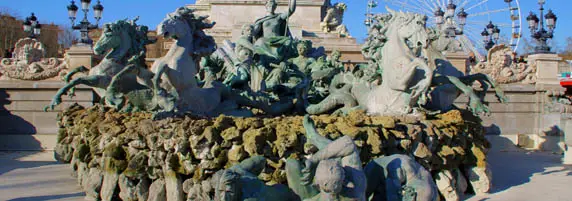
- The must-see places in the city are found in the old city, within its ancient walls. The historic part of the city, in its center, is listed as a UNESCO world heritage site and is organized around the courtyards, Clémenceau, Aristide Briand, and Marne, as well as Place Gambetta, Place de la Victoire, and Place des Grands Hommes.
You won’t be able to pass up on rue Sainte-Catherine (pedestrian shopping area), which is 1200 meters long and connects the Grand Theaters to Place de la Victoire.
Passing by this massive street, you’ll reach the northwestern part of the city where you’ll find chic restaurants and cafés as well as multiple luxury boutiques. You’ll find yourself in the capital of Aquitaine’s Golden Triangle, made up by the Cour Clémenceau, Cour de l’Intendance, and the Allées de Tourny. This Golden Triangle is the location of convents that were requisitioned during the French Revolution then reorganized around a central square, Place des Grands Hommes, and a few streets branching out with the names of intellectuals who inspired the French Revolution (Montesquieu, Rousseau, and Voltaire). - Arriving at the Monument of Gironde,erected in memory of the victims of the Terror, you’ll find yourself right by the Garonne. Wanting to walk along the river, you’ll pass by the largest public space in Europe, the Esplanade des Quinconces where there are statues of Montaigne and Montesquieu. Once you have crossed the street, you’ll find yourself on a large path reserved for pedestrians and cyclists. There you’ll be able to discover the modern bridge, Jacques Chaban Delmas (even more impressive when lit up at night); the Pont de Pierre; the Place de la Bourse where there are often events during the summer; etc. If you return to old part of the city, you’ll see nearby the Porte Cailhau built in the 15th century with a height of 35 meteres. You’ll be able to go through its two pillars, or even better, visit its first floor for free, or the entire building for 3.50€.
- In the northern part of the city, the Chartrons neighborhood was founded from the Chartreux convent, built in the 14th century by the inhabitants to protect themselves in a swampy place during the Hundred Years War. A street, Cours Xavier-Arnozan; a large pathway named today Cours de Verdun; and beautiful houses dating back to the 18th century add a certain interest to this neighborhood that has not stopped being, since 1990, the trading place for regional wines and has become a neighborhood dedicated to art. There you’ll find woodworkers, restaurants, specialists with gold, wood carvers, antique shops, art galleries, and other artistic workshops.
- In the northwest, the Saint-Seurin Basilica and the Palais Gallien, an old amphitheater, is also worth a detour..
- In the west, the modern neighborhood, Mériadeck, is the business center of Bordeaux, where there is also a large shopping center, a garden, and an ice skating rink.
Museums :
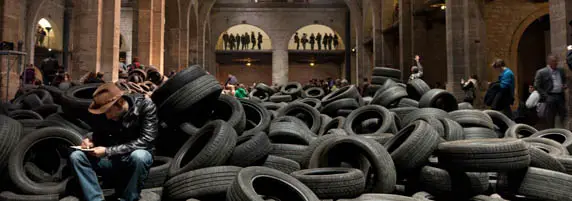
- The CAPC, the contemporary art museum is located in an old colonial warehouse. It has a permanent collection of 1300 works and welcomes temporary exhibits every year. 4€ at full price and 2€ at a reduced price for access to the permanent collection; 6.50€ at full price and 3.50€ at a reduced price for access to the entire ensemble of the musem.
- If you appreciate contemporary arty, you’ll also be able to go to Frac, the regional contemporary art fund of Aquitaine that has an important permanent art collection and also displays temporary exhibits. Access is free and available from 10am to 6pm Monday through Friday, 2:30pm to 6:30pm Saturdays.
- Like the majority of larger French cities, Bordeaux has its fine art museum. There, you will discover artistic works from Bordeaux and other places in Europe from different movements and time periods ( from the 16the to 20th century) displayed in a building built in 1881. Within its walls the museum also organizes meetings, concerts, and conferences. 4€ at full price and 2€ at a reduced rate for the permanent collections; 6.50€ at full price and 3.50€ at a reduced rate for dual ticket for the permanent collection and the temporary exhibits. It is free for those under 18.
- The Museum of Decorative Arts and Design is located in the Hôtel de Landres, one of the most beautiful monuments in the city, which will allow you to dive into the chic Bordeaux with its furniture and other objects from the time. 4.00€ at full price and 2.00€ at a reduced price for the permanent collection; 5€ at full price and 2.50€ at a reduced price for a double ticket for the permanent and temporary collections. It is free for youth under 18.
- Since Bordeaux is known for its wine-making activities, there you will find the Wine and Trade Museum. You are also allowed to have two tastings along with your visit for 10€ at full price and 5€ at a reduced price. Access is free for children, but no wine for them!
- The International Customs Museum will probably surprise you with the little marvels that it hides. Additionally, it is more entertaining and the young ones will enjoy it. Come discover this cabinet of curiosities open from Monday to Sunday, for 3€ (1.50€ at a reduced price, free for anyone under 18).
- The Museum of Aquitaine is perfect to understand the development of Bordeaux and its region from prehistory to today. Temporary exhibits pay homage to the cultures of the world. The schedule of events (with round tables, concerts, and workshops) is also rich. 4€ at full price and 2€ at a reduced price for the permanent collections; 6.50€ at full price and 3.50€ at a reduced price for a double ticket for both the permanent collections and exhibits. It is free for youth under 18.
- Another museum oriented towards history,National Center Jean Moulin brings together documents relating to the Second World War.
- Built during World War II, the undersea base of “Sleeping Beauty” de la "Belle Endormie" became a popular place in the city where you can attend temporary exhibits, concerts, and shows of all sorts.
- Cap Sciences is an educational and fun museum that the entire family will enjoy. The young ones as well as any curious visitor will appreciate the diversity of the exhibits, workshops, and gatherings that take place on the 1400m2 space. Entrance fees range from 0 to 7€, 6 and 12€ for kids’ workshops.
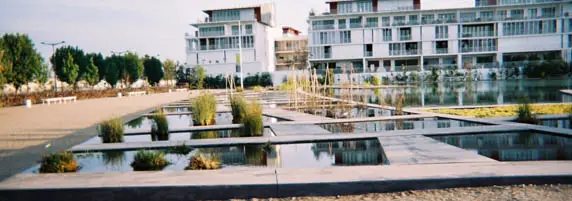
Go for a sunny walk or read in the grass:
- Bois de Bordeaux is the largest in the city. You’ll mostly find some room to sit down along the ponds or walk around, since it is 87 hectares.
- The Botanical Garden is a 600m2 mixture of colors and species in 44 plots.
*This travel guide was published in November 2014, prices may then vary.


